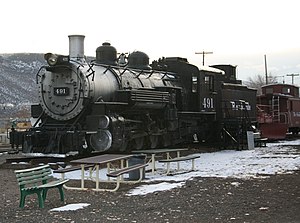D&RGW K-37
| Denver & Rio Grande Western K-37 | |||||||||||||||||||||||||||||||||||||||
|---|---|---|---|---|---|---|---|---|---|---|---|---|---|---|---|---|---|---|---|---|---|---|---|---|---|---|---|---|---|---|---|---|---|---|---|---|---|---|---|

D&RGW #491 at Colorado Railroad Museum
|
|||||||||||||||||||||||||||||||||||||||
|
|||||||||||||||||||||||||||||||||||||||
|
|||||||||||||||||||||||||||||||||||||||
|
|||||||||||||||||||||||||||||||||||||||
|
|||||||||||||||||||||||||||||||||||||||
| Type and origin | |
|---|---|
| References: Dimensions are as rebuilt unless noted |
|
| Power type | Steam |
| Builder | Baldwin Locomotive Works |
| Build date | 1902 |
| Rebuilder | D&RGW Burnham Shops |
| Rebuild date | 1928–1930 |
| Number rebuilt | 10 |
| Specifications | |
|---|---|
| Configuration: |
|
| • Whyte | Original: 2-8-0 Rebuilt: 2-8-2 |
| • UIC | 1′D1′ h2 |
| Gauge | Original: 4 ft 8 1⁄2 in (1,435 mm) Rebuilt: 3 ft (914 mm) |
| Leading dia. | Original: unknown Rebuilt: 28 in (711 mm) |
| Driver dia. | Original: 55 in (1,397 mm) Rebuilt: 44 in (1,118 mm) |
| Trailing dia. | Original: none Rebuilt: 28 in (711 mm) |
| Wheelbase | 29 ft (8.8 m) |
| Length | 41.1 ft (12.5 m) |
| Width | 10.4 ft (3.2 m) |
| Height | Engine: 13.3 ft (4.1 m) Tender: 13.5 ft (4.1 m) |
| Loco weight | 183,920 pounds (83,420 kg) |
| Boiler pressure | 200 psi (1.38 MPa) |
| Cylinders | Two |
| Cylinder size | 20 in × 24 in (508 mm × 610 mm) |
| Valve gear | Walschaerts |
| Loco brake | Air |
| Train brakes | Air |
| Performance figures | |
|---|---|
| Tractive effort | 37,100 lbf (165 kN) |
| Career | |
|---|---|
| Operators | DRGW, D&SNG, C&TS |
| Class | D&RG: 190 D&RGW: C-41 after rebuild: K-37 |
| Numbers | 490–499 |
| Locale | Colorado and New Mexico |
| Retired | 1955 (#496), 1962-1970 |
| Disposition | Eight preserved; two (#490, 496) scrapped |
Denver & Rio Grande Western K-37s are 2-8-2, Mikado type, narrow gauge steam locomotives. They were originally built by Baldwin as part of an order for thirty standard gauge 2-8-0, Consolidation type, locomotives, class 190, in 1902. They were renumbered into class C-41 (meaning 41,000 lbs of tractive effort) during the railroad's reorganization in 1924 and were converted to three foot gauge in 1928-30 at the railroad's Burnham Shops in Denver, CO with many new parts including new frames and smaller drivers. They were then renumbered into class K-37.
The locomotives are of outside-frame design, with the driving wheels placed between the two chassis frames which support the boiler, but with the cylinders, driving rods, counterweights and valve gear on the outside. This general arrangement is shared with the earlier K-27, K-28 and K-36 Mikado engines.
The locos worked out of Salida, Colorado to Gunnison, Colorado and up the Crested Butte Branch as well as the Monarch Branch. The locos also worked out of Alamosa, Colorado to Antonito over Cumbres Pass to Chama and on to Durango and the Farmington Branch. Like the K-36s the locos were not permitted West of Gunnison or on the Silverton branch. However, the Silverton branch has since been upgraded the track and line to handle K-36s and K-37s. 3 K-37s, 493, 491, and 499, were equipped with steam heat and signal lines so they can haul passenger trains like the San Juan Express and Shavano.
...
Wikipedia
